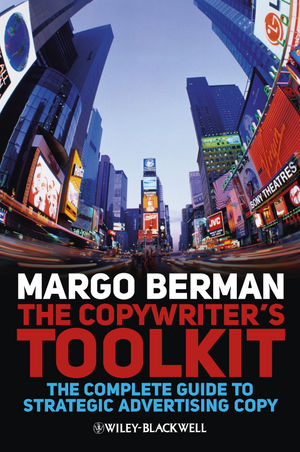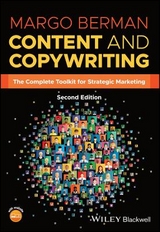
The Copywriter's Toolkit
Wiley-Blackwell (Verlag)
978-1-4051-9953-7 (ISBN)
- Titel erscheint in neuer Auflage
- Artikel merken
Written from a real-world perspective by an award-winning copywriter/producer/director, this comprehensive guide is what every writer needs to create powerful, strategic ad copy. Focusing on strategy, technique, and the skills needed to write for different media, The Copywriter’s Toolkit book will sharpen your copywriting skills whatever your level.
Introduces essential conceptual strategies and key writing techniques for result-driven copy
Provides practical advice on writing for specific media including: print, radio, TV, websites, blogs, social media, ambient, digital, direct mail, product packaging, and viral marketing
Covers all areas of copy development: on-strategy and on-target messaging; headline and slogan creation; brand personality and tone of voice; broadcast production conceptualization and print / digital typesetting consideration
Presents innovative visual examples from exciting multimedia campaigns, comments from copywriters at world-renowned agencies, inspiring radio scripts, TV scripts and storyboards, effective blog posts, imaginative package copy, and more
Shares invaluable writing tips and insights from award-winning copywriters currently at global agencies
Includes supplementary website an instructor’s manual, sample syllabus, PowerPoint presentations, and creative assignments, as well as student study aids, flashcards, podcasts and/or webinars by the author, and links to sample and featured campaigns, agencies, and related videos
Margo Berman is Professor of Advertising at Florida International University and has more than 20 years' experience as a creative director and copywriter. She is the author of Street-Smart Advertising: How to Win the Battle of the Buzz (2010) and co-author (with Robyn Blakeman) of The Brains Behind Great Ad Campaigns: Creative Collaboration between Copywriters and Art Directors (2009).
Preface xii
Acknowledgments xv
Chapter One The Persuasive Word: Strategy ABCs: Audience, Benefits, And Creative Briefs 1
Thinking about strategy first 2
Examining the brief: an up-close look 4
Templates 1.1: The shorter creative brief 4
Templates 1.2: The creative brief 5
Gaining deeper audience insight through VALS and observational research 6
Useful info 1.3: VALS comparison starting with highest incomes on top 10
Understanding secondary audience versus primary audience 10
Delving into consumer insights 11
Realizing the importance of a benefit 12
Creative strategy exercises 13
Notes 14
Chapter Two The Strategic Word: Strategy Categories 15
Using strategic thinking strengthens each touchpoint 16
Analyzing types of strategies 17
Keeping a handy reference list of strategies 18
Evaluating strategies and needs 23
Applying different types of positioning 27
Inventing the USP: selling uniqueness 28
Creating the main message: campaign slogans 28
Deciding the tone of voice 29
Considering competitors 29
Designing tactics 29
Advice from the pros 2.1: Charlie Hopper’s writing for specific media tips 29
Final creative direction checklist 30
Creative strategy exercises 30
Notes 31
Chapter Three The Chosen Word: Writing Techniques 32
Developing a strong message with legs 33
Determining the tone of voice 34
Finding the point of view 34
Writing the way you speak 35
Writing to your audience 37
Checklist 3.1: A quick “Grammar” copywriting checklist 38
Writing for the medium and the senses 39
Writing for celebrities 40
Finding your own voice: some tips 41
Quick chapter overview 41
Checklist 3.2: Writing technique tips checklist 42
Creative writing exercises 42
Notes 43
Chapter Four The Sticky Word: Headline and Slogan Techniques 44
Devising ad structure: headlines, subheads, body copy, and slogans 45
Remembering the call to action 46
Thinking up catchy headlines and subheads 46
Reviewing different kinds of headlines 47
Making up sticky slogans: the backbone of campaigns 50
Adding power to your writing 55
Copywriting insights and tips 55
Making your copy sticky 56
Creative writing exercises 57
Notes 57
Chapter Five The Written Word: Print 59
Writing for the printed page 60
Formulating one focused message 61
Remembering the reader 61
Checklist 5.1: Copy checklist 62
Discovering basic copy format 64
Templates 5.2: Basic print ad copy format 64
Templates 5.3: Basic brochure copy format 65
Focusing on strategy, audience, benefits, tone of voice, message, and relevance 65
Recognizing categories of effective messages 66
Exploring playful, humorous, empathetic print ads 67
Studying more ads that empathize with the target 69
Identifying ads with an insider’s understanding 71
Shaping witty headlines that say it all 74
Noticing ads that don’t look like ads 77
Copywriting: a closer look 80
Print writing tips 80
Useful info 5.4: Common qualities in featured campaigns 80
Creative print checklist 81
Checklist 5.5: Print campaign checklist of questions 82
Creative print ad exercises 83
Notes 84
Chapter Six The Spoken Word: Radio 85
Becoming a radio aficionado 86
Tips and rules 6.1: How to write for the ear 87
Learning some radio tips from the masters 87
Tips and rules 6.2: Basic radio writing rules 90
Observing a few more radio writing “rules” 91
Applying basic radio copy format 91
Finding out more about radio format 91
Templates 6.3: Standard radio format 92
Useful info 6.4: Common radio terms 93
Thinking about production from the start 96
Using union and nonunion talent, music, and sound effects 97
Working with and directing the talent 98
Understanding radio dayparts 99
Exploring examples of great radio scripts 101
Script 1: Silver in the City :60 radio, “lead lining” 101
Script 2: Silver in the City, :60 radio, “seasons/vortex” 102
Script 3: Goodwill, :60 radio, “his, hers and ours” 102
Script 4: Pop Weaver Popcorn, :60 radio, “tv spot on the radio” 103
Script 5: Pop Weaver Popcorn, :30 radio, “arlene” 104
Script 6: Motel 6, :60 radio, “comparison” 104
Script 7: The Laughing Cow “Valley Girl” and “Enid” radio campaign 105
Advice from the pros 6.5: Joy Golden’s 10 secrets for creating successful comedy radio commercials 110
Writing radio tips 111
Advice from the pros 6.6: Charlie Hopper’s tips for writing for radio 111
Reviewing radio: the wrap up 113
Creative radio exercises 113
Notes 114
Chapter Seven The Animated Word: Television 115
Scrutinizing television writing: what’s the secret? 116
Analyzing TV writing: where to begin 116
Tips and rules 7.1: The three Rs 116
Reviewing universal truths 120
Scripts and examples 7.2: Bridgestone TV script: “taters” 123
Discovering more about universal truths 125
Scripts and examples 7.3: Bridgestone TV script: “scream” 129
Scripts and examples 7.4: Bridgestone TV script: “hot item” 131
Portraying common goals 132
Scripts and examples 7.5: Angie’s List TV script: “pay per view” 133
Scripts and examples 7.6: Angie’s List TV script: “red paint” 136
Seeing how exaggeration, humor, and strong copy drive home benefits 137
Realizing a great tip for TV spot length 145
Investigating ways to present TV ideas 145
Scripts and examples 7.7: Story script example: Hewlett-Packard, :30 TV, “Live Wirelessly. Print Wirelessly.” 147
Learning from beloved Super Bowl spots 148
Identifying types of TV commercials 148
Useful info 7.8: Some popular types of TV spots 149
Writing TV scripts 151
Tips and rules 7.9: Basic TV writing rules for scripts 152
Absorbing key copywriting tips 154
Tom Amico’s tips (Kaplan Thaler Group) 154
Sara Rose’s tips (Goodby Silverstein & Partners) 154
Vinny Warren’s tips just on screenwriting (The Escape Pod) 155
Casting TV talent 156
Becoming familiar with TV terminology 156
Useful info 7.10: Common TV terms 157
Templates 7.11: Basic TV copy format 160
Scripts and examples 7.12: Weight Watchers “momentum” campaign examples 160
Creative TV exercises 161
Notes 165
Chapter Eight The Delivered And Abridged Word: Direct Mail, Mobile, And Small-Space Writing 167
Exploring direct mail 168
Grasping why direct mail? 168
Checklist 8.1: Direct mail handy checklist 169
Learning a few pointers about writing self-promotion letters 172
Advice from the pros 8.2: Drayton Bird’s letter writing principles 173
Creating messages for mobile e-mail marketing 174
Writing copy for product packaging 174
Examining examples of creative package copy 174
Advice from the pros 8.3: Five tips for better results with mobile e-mail marketing from Shane Ketterman 175
Checklist 8.4: Small-space writing checklist 178
Scripts and examples 8.5: Headlines for Ugly Mug Coffee bags 179
Learning some tips for small-space writing from Charlie Hopper 183
Advice from the pros 8.6: Basic writing tips from Curt Mueller 189
Creating coupon copy 190
Examining online banner ad copy 190
Understanding catalog copywriting 191
Scripts and examples 8.7: Ovation Guitars copy 192
Checklist 8.8: Catalog copywriting checklist 193
Creative abridged writing exercises 193
Notes 194
Chapter Nine The Ambient and Moving Word: Out-Of-Home and Transit 196
Starting from the medium 197
Useful info 9.1: Kinds of ambient media 199
Noticing messages wherever you are 201
Looking closely at out-of-home messages 201
Tips and rules 9.2: Tips for writing ambient copy 202
Thinking about surprising the audience 202
Understanding your audience’s frame of reference 207
Being irreverent and still effective 212
Taking a once touchy subject into a humorous campaign 217
Finding new places to advertise 220
Checklist 9.3: Creative ambient checklist 222
Creative ambient exercises 222
Notes 223
Chapter Ten The Online Communal Word: Digital Dialogue, Virtual Community, Blogging 224
Interacting with your online audience 225
Writing for the Web 225
Surfing the Web 225
Talking to the reader 226
Evaluating the copy’s tone of voice 226
Including clever headlines 227
Scripts and examples 10.1: Fun website headlines 227
Advice from the pros 10.2: Warning: use these five headline formulas at your own risk 228
Analyzing the message 229
Tips and rules 10.3: The 10 basic rules of copywriting 229
Creating a successful blog 229
Tips and rules 10.4: 10 steps for a successful blog series 230
Reading blogs for digital writing tips 230
Editing: Charlie Hopper’s tips to cut copy 231
Advice from the pros 10.5: Andy Beal’s top blogging tips 232
Useful info 10.6: Top copy-specific blogs from “top copywriting sites” 233
Looking into blogs for ad agencies 234
Learning blogging tips 234
Learning the rules of guest blogging 235
Revealing more bloggers’ observations 235
Looking at online versus print articles 237
Useful info 10.7: Social media ethical issue terms 239
Reviewing digital writing 240
Checklist 10.8: Blogging checklist 240
Creative blogging exercises 240
Notes 241
Chapter Eleven The Online Word: Websites 242
Considering different types of digital directions 243
Examining a site with straightforward copy 244
Scripts and examples 11.1: Where we come from 244
Looking at copy on two digital agency sites 245
Examining a humorous site 249
Understanding SEO as a writer 249
Advice from the pros 11.2: Derek Cromwell’s website copywriting tips 250
Staying current about SEO 251
Useful info 11.3: 24 awesome SEO blogs everyone should read 251
Learning digital media from online experts 253
Advice from the pros 11.4: Alessandra Lariu’s digital writing tips 254
Useful info 11.5: Common Internet terms 257
Checklist 11.6: Online writing checklist 262
Creative online writing exercises 262
Notes 263
Chapter Twelve The Buzz Word: Interactive Engagement, Social Media, Viral Marketing 265
Understanding interactivity 266
Asking: what’s the point of interaction? 266
Considering sendable campaigns 267
Asking consumers to share their stories 267
Thinking about interactivity 268
Creating other ways to use interactivity 270
Discovering how to create buzz 274
Creating buzz with viral marketing / word of mouth 276
Asking why you responded 279
Understanding when buzz goes wrong 280
Looking at social networking: Facebook, Twitter, and more 281
Communicating online is similar to other media 283
Advice from the pros 12.1: Three digital writing tips from Peter Sena II 284
Watching new media 284
Using new media for marketing messages 285
Using social media to create viral reactions 286
Designing games to recruit staff 286
Final interactive media checklist 286
Creative interactive exercises 287
Notes 287
Chapter Thirteen The Multimedia Word: Integrated Campaigns 289
Developing ideas that spin out 290
Thinking about how small-space writing differs from other media 293
Creating messages that move from one medium into another 294
Thinking about multimedia from the beginning 297
Checking that you’re writing for the eye, ear, and imagination 297
Reminding consumers of the benefits in all media 298
Including target-specific ambient and interactive advertising 299
Being irreverent can create unforgettable messages 300
Creating a new approach to a normally stuffy category 301
Learning Charlie Hopper’s media-focused writing tips 302
Advice from the pros 13.1: Hopper’s top writing tips 303
Gaining some insights into how Crispin Porter + Bogusky think 304
Looking at more multimedia campaigns 304
Scripts and examples 13.2: Mount Sinai, :60
radio, “Two-Year-Old” 307
Single medium campaigns 307
Checklist 13.3: Multimedia writing tips checklist 310
Multimedia messaging exercises 311
Notes 312
Chapter Fourteen the Global Word: Multicultural and International Campaigns 314
Revisiting universal truths as a core message 315
Writing for hispanic markets 316
Using global truths for today’s diverse market 318
Advice from the pros 14.1: Five writing tips from George L. San Jose 346
Creating international campaigns 347
Seeing how concepts move into other markets 347
Taking a tagline into other countries 347
Changing consumer behavior with fun 357
Reaching out with on-the-go solutions 358
Using the digital world to go global 359
Observing international campaigns 360
Advice from the pros 14.2: Three tips for writing to biculturals from Carlos Menendez 361
Checklist 14.3: Multilingual and multicultural writing tips checklist 361
Multilingual and international messaging exercises 362
Notes 364
Suggested Reading 365
Index 368
| Verlagsort | Hoboken |
|---|---|
| Sprache | englisch |
| Maße | 185 x 239 mm |
| Gewicht | 726 g |
| Themenwelt | Sozialwissenschaften ► Kommunikation / Medien |
| Wirtschaft ► Betriebswirtschaft / Management ► Marketing / Vertrieb | |
| ISBN-10 | 1-4051-9953-9 / 1405199539 |
| ISBN-13 | 978-1-4051-9953-7 / 9781405199537 |
| Zustand | Neuware |
| Informationen gemäß Produktsicherheitsverordnung (GPSR) | |
| Haben Sie eine Frage zum Produkt? |
aus dem Bereich



